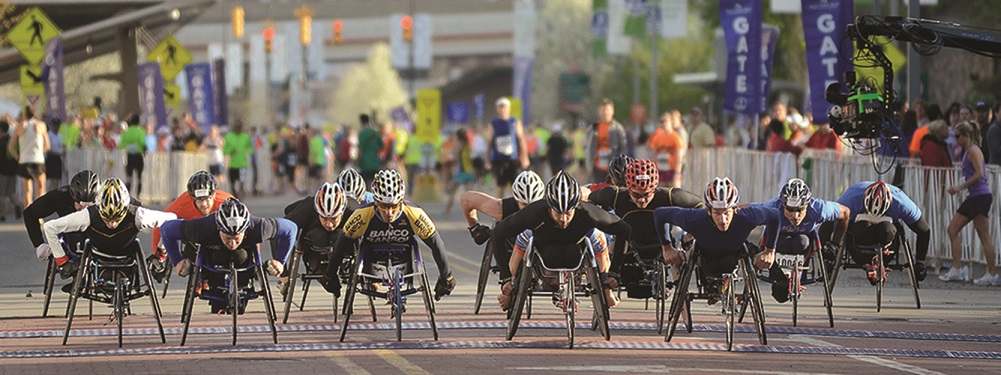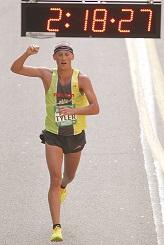
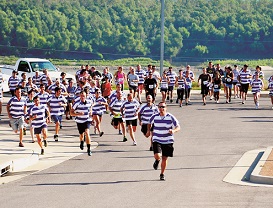
Similarly, the annual Running of the Bulls in Eugene, Oregon, unleashes roller derby girls who try to steal red sashes from runners.
Unconventional events like these are cropping up all over the country. In fact, between 2009 and 2013, the number of estimated finishers in such non-traditional themed runs and obstacle courses as The Color Run, Tough Mudder and even The Ugly Sweater Run exploded from low six figures to 4 million, according to Running USA, a nonprofit organization dedicated to distance running.
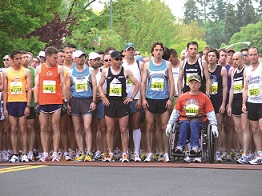 Created with the non-competitive runner in mind, these events focus on the social and team-building aspects of running and seek to make the sport fun for individuals bored or, worse, turned off by straightforward running. Running USA reports that approximately 60 percent of participants in more than 300 events hosted by The Color Run — the self-proclaimed “Happiest 5K on the Planet,” during which runners are doused with colorful paint at each kilometer — have never previously run a 5K.
Created with the non-competitive runner in mind, these events focus on the social and team-building aspects of running and seek to make the sport fun for individuals bored or, worse, turned off by straightforward running. Running USA reports that approximately 60 percent of participants in more than 300 events hosted by The Color Run — the self-proclaimed “Happiest 5K on the Planet,” during which runners are doused with colorful paint at each kilometer — have never previously run a 5K.“Most are brand-new runners of all ages with an approximate gender split that wouldn’t even dream of signing up for their typical local road race,” Running USA wrote in its “2014 State of the Sport.” “Event organizers are scrambling to join the popularity and introduce the next new series. But as new themed races are added across the nation, at some point, there will be market saturation.”
That hasn’t happened yet, which is good news for communities large and small seeking to establish a greater foothold in the running community or build on an already established racing reputation while generating overnight hotel stays.
Take tiny Bridgeport, West Virginia, with a population of about 8,400 and a history that dates back to pre-Revolutionary War times. Bridgeport holds multiple 5K events, and officials there recently submitted a request for proposal to host a major collegiate cross-country race. “We have a lot of running activity going on for a small city our size,” says Michelle Duez, executive director of the Greater Bridgeport Convention & Visitors Bureau.
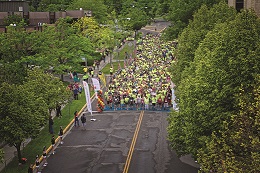
“I think a lot of these race directors are getting people off the couch and doing something they can feel good about,” says Mike Guswiler, president of the West Michigan Sports Commission in Grand Rapids.
“The Color Runs, Dirty Dashes and 5Ks with a unique component can get people to start thinking about competing in more serious and straightforward runs,” adds Janis Ross, executive director of Eugene, Cascades & Coast Sports in Eugene, Oregon. “I think there’s room for everything.”
What follows is a sampling of what “everything” means in six key running communities.
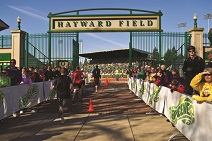 Eugene, Oregon
Eugene, OregonKnown universally as “Track Town, USA,” Eugene hosted its first Dirty Dash in 2012. The event — a muddy obstacle course run in which “military boot camp meets your inner five-year-old’s fantasy,” according to The Dirty Dash website — proved to be so popular that registration was capped at 5,000, and discussions are underway to turn the annual Dirty Dash into a two-day event. Eugene also hosts a Color Dash, similar to The Color Run.
Then there are the Vineyards Marathon Grapes of Half — a half marathon taking runners on a tour of three premier wineries in the Willamette Valley and providing a free glass of wine at each one — the Running of the Bulls, the week-before-Christmas Holiday Half, a Mardi Gras 5K and similar themed events hosted by Pink Buffalo Racing. “These are the kinds of fun events that serious runners want to fill in their schedules,” Ross says.
Of course, an area as immersed in running as Lane County also boasts several events for those serious runners, including the Eugene Triathlon in August, the Fourth of July Butte to Butte between Spencer Butte and Skinner Butte, and the Rolf Prima Tri at the Grove in the Cottage Grove Lake recreation area, also in July.
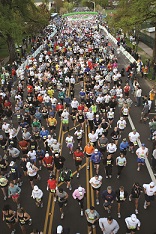 The Oregon Dunes Triathlon and Duathlon in May offers four race options with scenic courses that include a swim in Woahink Lake, biking along quiet country roads and running through the winding trails and campground of Honeyman Memorial State Park. All racers finish with a climb up the Oregon Dunes. “Nice way to end a run, huh?” Ross laughs.
The Oregon Dunes Triathlon and Duathlon in May offers four race options with scenic courses that include a swim in Woahink Lake, biking along quiet country roads and running through the winding trails and campground of Honeyman Memorial State Park. All racers finish with a climb up the Oregon Dunes. “Nice way to end a run, huh?” Ross laughs.The Eugene Marathon, held in 2015 one day after the Oregon Dunes Triathlon and Duathlon, has been called “the perfect race” by Runner’s Worldmagazine and offers a marathon, half marathon, 5K race and Kids Duck Dash. The event draws more than 5,000 runners from 48 states and five countries, and every finisher runs the final half-lap on the track at historic Hayward Field — host of six U.S. Olympic trials between 1972 and 2016.
“The endurance races factor right into title of Track Town USA, because track also has distance races,” Ross says. “Every event we host just adds to our reputation as a running destination.”
Jefferson City, Missouri
In addition to being home of the annual Prison Break, arguably one of the most unusual fun runs in the country, Jefferson City was the first locale to host an evening Color Run. “We asked The Color Run people if we could potentially have it at night, because it would allow some of our retail stores in the downtown area to stay open longer,” says Chris Wilson, sports sales manager at the Jefferson City Convention and Visitors Bureau. “We also wanted to have some live music that would keep participants around after the event.”
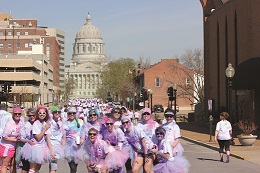
The Color Run and Prison Break have been among efforts to boost the city’s profile in the running community, but they’re not just focusing on novel events for novice runners. In June, Jefferson City hosted the first-ever Binder Blast Off-Road Triathlon to benefit several local YMCA and recreation programs. Held at the city’s largest park, the Binder Blast capped registration at a couple hundred, with plans to add more participants in future years, and it’s the first triathlon held in Jefferson City in a long time. “We’re trying to find ways to make it more runner friendly,” Wilson says.
Pittsburgh, Pennsylvania
Back in 2009, tourism officials in Pittsburgh re-evaluated the city’s commitment to running when the Pittsburgh Marathon returned after a five-year hiatus. “We wanted to make sure we were filling the hotel rooms as well as closing the streets,” says Jennifer Hawkins, director of sports marketing and development for Sports Pittsburgh. “Always, in the back of our minds, we’re asking how we can make an event into an opportunity to bring and keep people in town.”

The event has turned into a four-day festival with live music and an expo, and it’s now considered a signature event; Hawkins says no other local organizations dare schedule an activity on the Pittsburgh Marathon date.
Meanwhile, the GNC Live Well Liberty Mile for elite runners, which offers one of the top three largest prize purses in the country, is a one-mile dash — “I didn’t know people could run a mile quite that fast,” Hawkins laughs — down famed Liberty Avenue on a Friday evening in August. Then runners stay in Pittsburgh for the rest of the weekend. (For the record, the fastest Liberty Mile time is 3:58.4, set in 2012.)
Grand Rapids, Michigan

“People from around the country looking for adaptive sports opportunities put this one on their calendars,” he says, adding that more than 17,200 competitors participate in one of the Fifth Third River Bank Run’s six race divisions. “Beyond that, we probably have two dozen other running events per year in West Michigan.”
Those include the USA Triathlon-sanctioned Grand Rapids Triathlon (voted one of the “Top 5 Best Events for Newbies” by Triathlon Business International) and the Michigan Titanium (named one of the toughest triathlons by TBI), as well as the sprint Millennium Triathlon and the Metro Health Grand Rapids Marathon. “Once you can establish your event and market it within the triathlon or marathon family, people will travel from other states to participate,” Guswiler says.
South Carolina
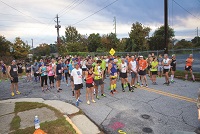
About 200 miles east of Clemson, in the Florence area, tourism officials want more runners, too. The big draw there is the Darlington Marathon, a Boston Marathon qualifier held at the nearby NASCAR-sanctioned Darlington Raceway. The starting line is on the track, and runners then make their way through the city, which features five historical districts, before concluding at the track’s finish line. “We think the racetrack brings a whole new feel to the marathon,” says Jade Perkins of the Florence Area Sports Council.
Florence hosts Run Like a Nut, part of that city’s Annual Pecan Festival every November, with routes across flat terrain in established neighborhoods near the city’s downtown district. Perkins says more running and obstacle-course events, such as the Tough Mudder or Spartan Race, would be good for the city. “A lot of times, we can pull from neighboring states,” she says. “That’s because runners are always looking for that next opportunity to get a faster time.”
